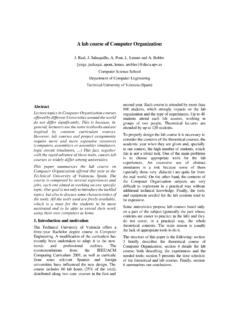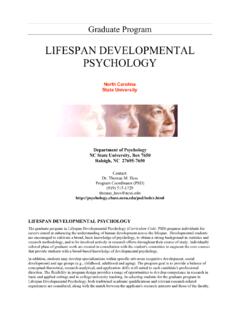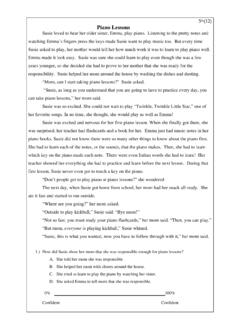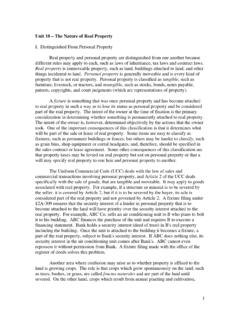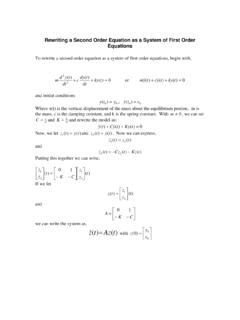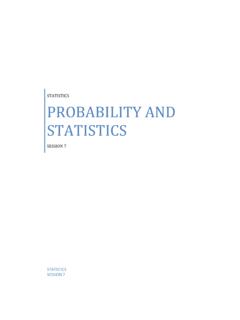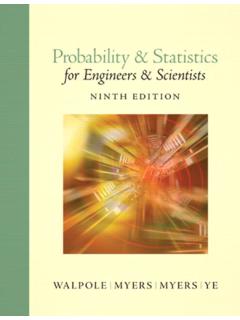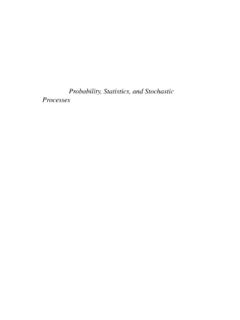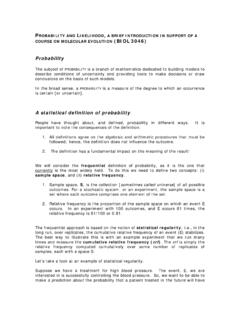Transcription of An Introduction to Basic Statistics and Probability
1 An Introduction to Basic Statisticsand ProbabilityShenek HeywardNCSUAn Introduction to Basic Statistics and Probability p. 1/40 OutlineBasic Probability conceptsConditional probabilityDiscrete Random Variables and Probability DistributionsContinuous Random Variables and ProbabilityDistributionsSampling Distribution of the Sample MeanCentral Limit TheoremAn Introduction to Basic Statistics and Probability p. 2/40 Idea of ProbabilityChance behavior is unpredictable in the short run, buthas a regular and predictable pattern in the long any outcome of a randomphenomenom is the proportion of times the outcomewould occur in a very long series of Introduction to Basic Statistics and Probability p.
2 3/40 TerminologySample Space- the set of all possible outcomes of arandom phenomenonEvent- any set of outcomes of interestProbabilityof an event - the relative frequency of thisset of outcomes over an infinite number of trialsPr(A) is the Probability of event AAn Introduction to Basic Statistics and Probability p. 4/40 ExampleSuppose we roll two die and take their sumS={2,3,4,5, ..,11,12}Pr(sum= 5) =436 Because we get the sum of two die to be 5 if we roll a(1,4),(2,3),(3,2) or (4,1).An Introduction to Basic Statistics and Probability p. 5/40 NotationLetAandBdenote two Bis the event that eitherAorBor both Bis the event that denoted the event thatAdoes not thatPr(A) = 1 Pr(A).
3 An Introduction to Basic Statistics and Probability p. 6/40 DefinitionsAandBaremutually exclusiveif both cannot occur atthe same eventsif and only ifPr(A B) = Pr(A) Pr(B).An Introduction to Basic Statistics and Probability p. 7/40 Laws of ProbabilityMultiplication Law: IfA1, , Akare independentevents, thenPr(A1 A2 Ak) = Pr(A1) Pr(A2) Pr(Ak).Addition Law: IfAandBare any events, thenPr(A B) = Pr(A) + Pr(B) Pr(A B)Note: This law can be extended to more than 2 Introduction to Basic Statistics and Probability p. 8/40 Conditional ProbabilityTheconditional probabilityofBgivenAPr(B|A) =Pr(A B)Pr(A)AandBare independent events if and only ifPr(B|A) = Pr(B) = Pr(B|A)An Introduction to Basic Statistics and Probability p.
4 9/40 Random VariableArandom variableis a variable whose value is anumerical outcome of a random phenomenonUsually denoted byX, beDiscrete - a random variable that has finite orcountable infinite possible valuesExample: the number of days that it rains yearlyContinuous - a random variable that has an(continuous) interval for its set of possible valuesExample: amount of preparation time for the SATAn Introduction to Basic Statistics and Probability p. 10/40 Probability DistributionsTheprobability distributionfor a random variableXgivesthe possible values forX, andthe probabilities associated with each possible value( , the likelihood that the values will occur)The methods used to specify discrete are similar to (but slightly different from)those used to specify continuous prob.
5 Introduction to Basic Statistics and Probability p. 11/40 Probability Mass Functionf(x)- Probability mass function for a discrete randomvariableXhaving possible valuesx1, x2, f(xi) = Pr(X=xi)is the Probability thatXhas thevaluexiProperties0 f(xi) 1 if(xi) =f(x1) +f(x2) + = 1f(xi)can be displayed as a table or as a mathematicalfunctionAn Introduction to Basic Statistics and Probability p. 12/40 Probability Mass FunctionExample: (Moore p. 244)Suppose the random variableX is the number of rooms in a randomly chosenowner-occupied housing unit in Anaheim, distribution of X is:Rooms X1234567 Probability .083 .071 .076 .139 .210.
6 224 .197An Introduction to Basic Statistics and Probability p. 13/40 Parameters vs. StatisticsAparameteris a number that describes the its value is a number that can be computed from thesample data without making use of any practice, we often use a statistic to estimate anunknown Introduction to Basic Statistics and Probability p. 14/40 Parameter vs. Statistic ExampleFor example, we denote the population mean by ,andwe can use the sample mean xto estimate .Suppose we wanted to know the average income ofhouseholds in estimate this population mean income ,we mayrandomly take a sample of 1000 households andcompute their average income xand use this as anestimatefor.
7 An Introduction to Basic Statistics and Probability p. 15/40 Expected ValueExpected Value ofXor (population) mean =E(X) =R i=1xiPr(X=xi) =R i=1xif(xi),where the sum is overRpossible befinite or to the sample mean xRepresents the "average" value ofXAn Introduction to Basic Statistics and Probability p. 16/40 Variance(Population) variance 2=V ar(X)=R i=1(xi )2Pr(X=xi)=R i=1x2iPr(X=xi) 2 Represents the spread, relative to the expected value,of all values with positive probabilityThestandard deviationofX, denoted by , is thesquare root of its Introduction to Basic Statistics and Probability p. 17/40 Room ExampleFor the Room example, find the followingE(X)V ar(X)Pr[a unit has at least 5 rooms]An Introduction to Basic Statistics and Probability p.
8 18/40 Binomial DistributionStructureTwo possible outcomes: Success (S) and Failure (F).Repeat the situationntimes ( , there arentrials).The " Probability of success," p, is constant on trials are Introduction to Basic Statistics and Probability p. 19/40 Binomial DistributionLetX= the number of S s innindependent trials.(Xhas valuesx= 0,1,2, , n)ThenXhas a binomial distribution with binomial Probability mass function isPr(X=x) =(nx)px(1 p)n x,x= 0,1,2, , nExpected Value: =E(X) =npVariance: 2=V ar(X) =np(1 p)An Introduction to Basic Statistics and Probability p. 20/40 ExampleExample: (Moore ) Each child born to a particularset of parents has Probability of having blood typeO.
9 If these parents have 5 children, what is theprobability that exactly 2 of them have type O blood?LetX= the number of boysPr(X= 2) =f(2) =(52)(.25)2(.75)3=.2637An Introduction to Basic Statistics and Probability p. 21/40 ExampleWhat is the expected number of children with type Oblood? = 5(.25) = is the Probability of at least 2 children with type Oblood?Pr(X 2) =5 k=2(5k)(.25)k(.75)5 k= 1 1 k=0(5k)(.25)k(.75)5 k=.3671875An Introduction to Basic Statistics and Probability p. 22/40 Continuous Random Variablef(x)- Probabilitydensityfunction for a continuousrandom variableXPropertiesf(x) 0 f(x)dx= 1P[a X b] = baf(x)dxImportant NotesP[a X a] = aaf(x)dx= 0 This implies thatP[X=a] = 0P[a X b] =P[a < X < b]An Introduction to Basic Statistics and Probability p.
10 23/40 SummarizationsSummarizations for continuous prob. distributionsMean or Expected Value ofX =EX= xf(x)dxVariance 2=V arX= (x EX)2f(x)dx= x2f(x)dx (EX)2An Introduction to Basic Statistics and Probability p. 24/40 ExampleLetXrepresent the fraction of the population in acertain city who obtain the flu (x) ={2xwhen0 x 1, P(1/4 X 1/2)P(1/4 X 1/2) = 1/21/4f(x)dx= 1/21/42xdx= 3/16An Introduction to Basic Statistics and Probability p. 25/40 Examplef(x) ={2xwhen0 x 1, P(X 1/2)FindEXFindV arXAn Introduction to Basic Statistics and Probability p. 26/40 Normal DistributionMost widely used continuous distributionAlso known as the Gaussian distributionSymmetricAn Introduction to Basic Statistics and Probability p.}}
